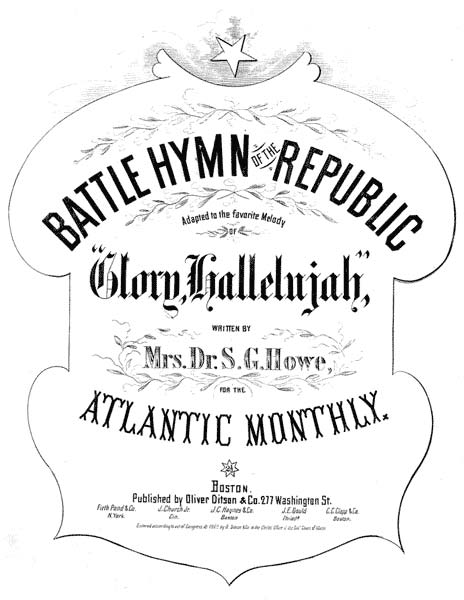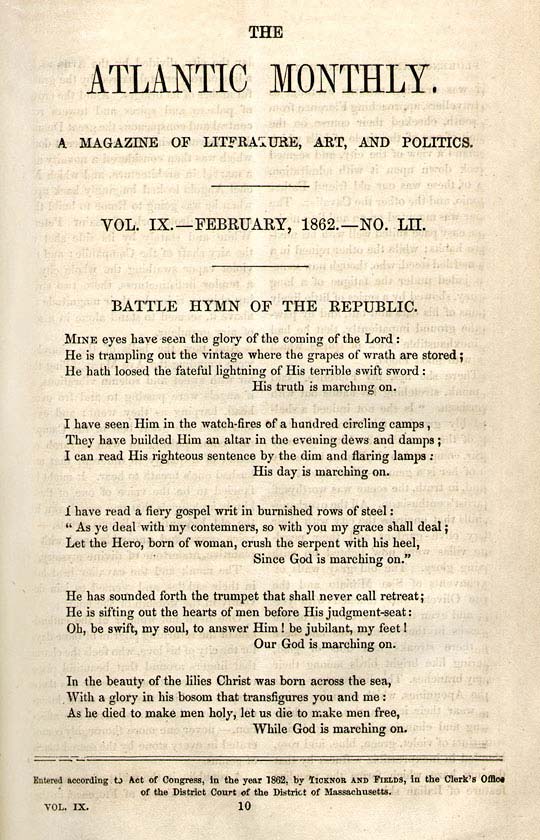“The Battle Hymn of the Republic” was written by Julia Ward Howe, and she used the music from “John Brown‘s Body.” She was also famous for the lyrics she wrote in November 1861, which was initially published in The Atlantic Monthly, in February 1862. The Battle Hymn creatively links the final judgment of the wicked, as stated in the New Testament, with the Civil War of America. Since the time it was released, it became a popular patriotic song in the United States.
Features
The tune of the song was created in the 1850s. William Steffe was the one who made this tune, which quickly became famous across the United States. The first well-known lyrics of the song were called “Brothers, Will You Meet Me?” or “Canaan’s Happy Shore”. Furthermore, the song was sung by many people as a campfire song with a spiritual theme.
John Brown Song
 During the flag-raising event at Fort Warren, the John Brown Song was played publicly for the first time. It was May 1861, and the civil war had started in the past month. According to historians, there were troops who were singing the song, and they did so as they marched in Boston’s streets on July of 1861. Furthermore, there was a number of broadside prints of this song, as well as certain words similar to the John Brown song.
During the flag-raising event at Fort Warren, the John Brown Song was played publicly for the first time. It was May 1861, and the civil war had started in the past month. According to historians, there were troops who were singing the song, and they did so as they marched in Boston’s streets on July of 1861. Furthermore, there was a number of broadside prints of this song, as well as certain words similar to the John Brown song.
George Kimball made a report of how the second infantry battalion of Massachusetts, or the “Tiger Battalion,” worked out some of the lyrics to the song. Kimball also noted that some of the lines became the by-words of soldiers, and they were similar to the impromptu composition of campfire songs.
Some of the battalion leaders thought that the words were quite irreverent and coarse, and they opted for more fitting lyrics, yet there was no success. Soon, the lyrics were made for publication, which were prepared by the battalion members, alongside C.S. Hall, who was the publisher. They chose the right words and polished the verses that they believed were appropriate for the song. Moreover, they enlisted the help of a local poet in creating a more meaningful song.
Creation of the Hymn
 The battalion of Kimball was sent to Murray, in the early parts of the Civil War. Then, Julia Howe heard the song, which was during the public review of all the troops stationed on Upton Hill, in Virginia. Then, Rufu Dawes mentioned in his memoirs that a man who started singing was John Ticknor. He was in command of the “Company K”, who was a member of the Sixth Wisconsin Volunteer Infantry.
The battalion of Kimball was sent to Murray, in the early parts of the Civil War. Then, Julia Howe heard the song, which was during the public review of all the troops stationed on Upton Hill, in Virginia. Then, Rufu Dawes mentioned in his memoirs that a man who started singing was John Ticknor. He was in command of the “Company K”, who was a member of the Sixth Wisconsin Volunteer Infantry.
At the review, Rev. James Clarke was Howe’s companion during the review. He suggested Howe to write additional words for the song. Howe, who was currently in her room at the Willard Hotel Washington, woke up in the middle of the night with the perfect words of the song in her mind. Then, she began writing the words for the song, at night time, and she succeeded in creating remarkable lines to the Battle Hymn.
As she was writing the song, she remembered how she instantly came up with the right words that would express the main theme of the hymn. She felt a sense of urgency to complete the words and give life to the song. She also scrawled on the lines even without glancing at the words that she was writing on the paper.
It was in 1862 when Howe’s version of the Battle Hymn was published on The Atlantic Monthly. The sixth verse of the song was less popular, although it expressed the overall message and emotions in the hymn. Her deep love for anti-slavery laws and great support for the Union, as well as her musical talents, gave her the inspiration to create such an immensely beautiful and well-thought of lines for the song.
The score of the song has some similarities with the “Canaan’s Happy Shore”, although John Brown’s Body had more syllables in the verses. In the lyrics created by Howe, the words in each verse are rather longer, and there is a similar melody in the refrain as with the other parts of the song. Moreover, there were several dotted rhythms to its underlying melody, and this allows for additional complicated verses that will fit the similar melody as the rather short refrain.